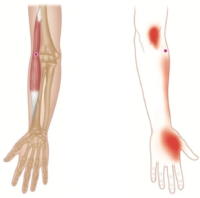 The brachioradialis runs from the lower, front part of the upper arm, across the elbow to the middle of the forearm. It flexes the forearm at the elbow. It is also capable of both pronation and supination, depending on the position of the forearm. Brachioradialis trigger points do not happen in isolation and are part of a pattern that includes the hand extensors and arm flexors.
The brachioradialis runs from the lower, front part of the upper arm, across the elbow to the middle of the forearm. It flexes the forearm at the elbow. It is also capable of both pronation and supination, depending on the position of the forearm. Brachioradialis trigger points do not happen in isolation and are part of a pattern that includes the hand extensors and arm flexors.
Pain from brachioradialis trigger points often originates on the outside of the forearm, near the elbow, and then progresses down the arm toward the base and web of the thumb.
 Brachialis trigger points are typically activated from a repetitive, forceful handgrip. This can include activities as diverse as weeding, excessive handshaking ironing, or throwing a frisbee for a long time. Once initial soreness develops, the tendency to “test” the muscle for improvement tends to worsen it.
Brachialis trigger points are typically activated from a repetitive, forceful handgrip. This can include activities as diverse as weeding, excessive handshaking ironing, or throwing a frisbee for a long time. Once initial soreness develops, the tendency to “test” the muscle for improvement tends to worsen it.
The functional unit of the brachioradialis includes the biceps and brachialis, but its dysfunction typically develops in conjunction with trigger points in the hand extensors and the supinator muscle. Corrective actions include trigger point pressure release, stretching, and avoiding activities that overload the muscle.
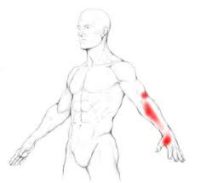 Pain at the base of the thumb, extending up through the forearm to the elbow, is typical of brachioradialis trigger points. Pain is usually concentrated on the base and web of the thumb and may pass over the wrist to the forearm. Pain may originate on the outside of the forearm, near the elbow, and then progress down the arm toward the base of the thumb.
Pain at the base of the thumb, extending up through the forearm to the elbow, is typical of brachioradialis trigger points. Pain is usually concentrated on the base and web of the thumb and may pass over the wrist to the forearm. Pain may originate on the outside of the forearm, near the elbow, and then progress down the arm toward the base of the thumb.
Brachioradialis trigger points do not happen in isolation and are part of a pattern that includes the hand extensors and arm flexors.
You may experience weakness in handgrip from other hand extensors but it is typically not caused directly by inhibition of the brachioradialis.
 Avoid repetitive actions that overload the muscle, such as excessive hand flexion/gripping.
Avoid repetitive actions that overload the muscle, such as excessive hand flexion/gripping.
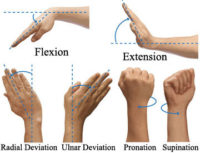 Limit flexion and ulnar deviation of the wrist. Limit forceful rotation of the arm and rapid flexion/extension of the elbow.
Limit flexion and ulnar deviation of the wrist. Limit forceful rotation of the arm and rapid flexion/extension of the elbow.
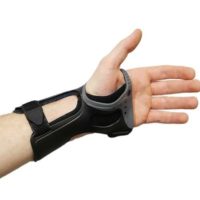 A wrist splint similar to ones sold for carpal tunnel syndrome will limit the flexion and ulnar deviation at the wrist.
A wrist splint similar to ones sold for carpal tunnel syndrome will limit the flexion and ulnar deviation at the wrist.
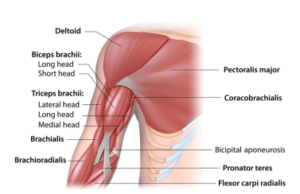 Myofascial self-care always starts with establishing a foundation of diaphragmatic breathing. Once you have taken a few moments to get in touch with your breath, we move on to self-compression and stretching. You may find that a warm bath or shower, or applying moist heat before you begin is helpful.
Myofascial self-care always starts with establishing a foundation of diaphragmatic breathing. Once you have taken a few moments to get in touch with your breath, we move on to self-compression and stretching. You may find that a warm bath or shower, or applying moist heat before you begin is helpful.
 You can use pressure self-release for the brachioradialis while seated.
You can use pressure self-release for the brachioradialis while seated.
Using your hand from the unaffected side, begin by using your fist to gently massage the area just above the elbow. Explore the muscle, note areas that are sorer, and bring your focus to them. You can also use your elbow for sustained pressure without stressing your fingers. To compress specific trigger points, use the knuckle (or thumb) of the forefinger from the unaffected side to probe deeper. Find the tender spot and apply pressure for up to 30 seconds as pain decreases. You can do this three to five times.
Many blood vessels and nerves in the arm are superficial, so pressure self-release should be done with caution. If you feel tingling or circulation changes in your hand you should reposition and take a different approach.
After completing self-compressions, move your arm through its range of motion and prepare to gently stretch your brachioradalis.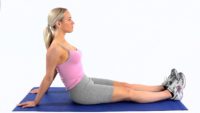
You can use your breath to deepen the stretch. Begin with a generous inhale and as you exhale, gently stretch by rotating the body away from the doorframe. You can repeat this sequence three to five times, up to four times per day.
The video below demonstrates several techniques for stretching the brachioradialis that include rotation of the forearms, along with flexion and extension of the wrists and elbows:
If you experience pain following pressure release and stretching, a cold pack may be helpful.
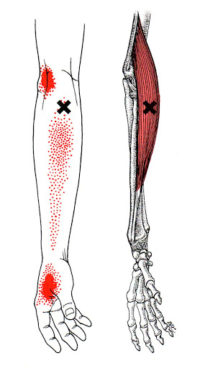 If you maintain a posture or activity that activates a trigger point in any muscle it will continue.
If you maintain a posture or activity that activates a trigger point in any muscle it will continue.
Brachioradialis trigger points are typically activated from a repetitive, forceful handgrip. This can include activities as diverse as weeding, ironing, or throwing a frisbee for a long time. Playing guitar or bass guitar can place the hand on the neck at a disadvantage. 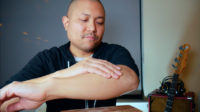
It is said that the brachioradialis rotates the forearm into pronation (palm down) or supination (palm up). However, it actually acts to return the arm to neutral after other muscles have rotated it. This means excessive rotation of your forearm can activate it as well.
Brachioradialis, like the other hand extensors, is more vulnerable when your wrist is deviated to the little finger side or flexed. For example, a heavy tennis racquet or a poor grip on a baseball bat can contribute to trigger point activations.
 Because the brachioradialis acts as a shunt muscle, stabilizing the elbow during centrifugal motion of the arm, activities like disc golf can be troublesome. Throwing a frisbee or other disc combines wrist flexion, ulnar deviation at the wrist, elbow flexion, and centrifugal extension of the arm.
Because the brachioradialis acts as a shunt muscle, stabilizing the elbow during centrifugal motion of the arm, activities like disc golf can be troublesome. Throwing a frisbee or other disc combines wrist flexion, ulnar deviation at the wrist, elbow flexion, and centrifugal extension of the arm.
With “tennis elbow”, brachioradialis trigger points can develop after a supinator (forearm rotator) activation, along with trigger points in the biceps and triceps.
 Once initial soreness develops, the tendency to “test” brachioradialis for improvement tends to worsen it. Placing any muscle in a shortened or lengthened position for an extended period of time can also activate trigger points in the muscle. This happens most often when we are sleeping but can happen during a variety of other activities too.
Once initial soreness develops, the tendency to “test” brachioradialis for improvement tends to worsen it. Placing any muscle in a shortened or lengthened position for an extended period of time can also activate trigger points in the muscle. This happens most often when we are sleeping but can happen during a variety of other activities too.
Prolonged flexion of your elbow, either during anything a local phone call or carrying a purse incorrectly to sleep or a surgical procedure, can also activate trigger points in the brachioradialis and related muscles.
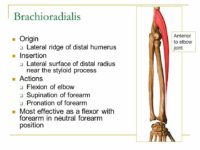 The brachioradialis flexes the forearm at the elbow. When the forearm is pronated, the brachioradialis tends to supinate as it flexes. In a supinated position, it tends to pronate as it flexes. In other words, brachioradialis acts to return a rotated forearm to neutral.
The brachioradialis flexes the forearm at the elbow. When the forearm is pronated, the brachioradialis tends to supinate as it flexes. In a supinated position, it tends to pronate as it flexes. In other words, brachioradialis acts to return a rotated forearm to neutral.
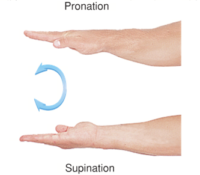 The brachioradialis is a stronger elbow flexor when the forearm is in a neutral position between supination and pronation. When pronated, the brachioradialis is more active during elbow flexion since the biceps brachii is at a mechanical disadvantage.
The brachioradialis is a stronger elbow flexor when the forearm is in a neutral position between supination and pronation. When pronated, the brachioradialis is more active during elbow flexion since the biceps brachii is at a mechanical disadvantage.
With the insertion of the muscle so far from the fulcrum of the elbow, the brachioradialis does not generate as much starting joint torque as the brachialis or the biceps. It is effective mainly when those muscles have already partially flexed at the elbow. Then, the brachioradialis flexes the forearm strongly at the elbow, especially when quick movement is required.
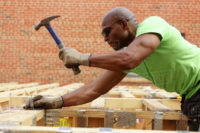 The brachioradialis muscle is used to stabilize the elbow during rapid flexion and extension while in a mid-position, such as in hammering. The brachioradialis is synergistic with the brachialis and biceps brachii. It is an antagonist of the triceps brachii and anconeus are antagonistic.
The brachioradialis muscle is used to stabilize the elbow during rapid flexion and extension while in a mid-position, such as in hammering. The brachioradialis is synergistic with the brachialis and biceps brachii. It is an antagonist of the triceps brachii and anconeus are antagonistic.
There is a delicate interplay between the brachialis, biceps brachii, and brachioradialis muscles during loaded flexion at the elbow.
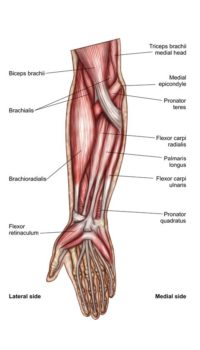 The brachioradialis runs from the lower third of the upper arm to the forearm.
The brachioradialis runs from the lower third of the upper arm to the forearm.
Structure
The brachioradialis is a superficial muscle on the lateral side (outside) of the forearm. It originates on the lateral supracondylar ridge of the humerus (upper arm bone), about a third of way up. It inserts in the forearm on the radius, at the base of its styloid process.
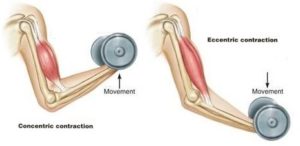 For example, in a biceps curl, you would use a concentric contraction of your biceps, coupled with an eccentric contraction of your triceps, to flex your elbow and push the weight up. As you lower the weight, eccentric contractions of your biceps are required to maintain control and prevent dropping the weight.
For example, in a biceps curl, you would use a concentric contraction of your biceps, coupled with an eccentric contraction of your triceps, to flex your elbow and push the weight up. As you lower the weight, eccentric contractions of your biceps are required to maintain control and prevent dropping the weight.
Isotonic Contractions
Isotonic contractions maintain constant tension in the muscle as the muscle changes length. This can occur only when a muscle’s maximal force of contraction exceeds the total load on the muscle. Isotonic muscle contractions can be either concentric (muscle shortens) or eccentric (muscle lengthens).Concentric Contractions
A concentric contraction is a type of muscle contraction in which the muscle shortens while generating force. This is typical of muscles that contract due to the sliding filament mechanism, and it occurs throughout the muscle. Such contractions also alter the angle of the joints to which the muscles are attached.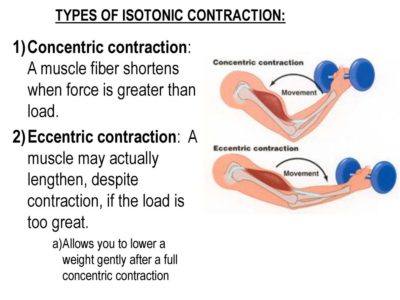 This occurs throughout the length of the muscle, generating force; causing the muscle to shorten and the angle of the joint to change. For instance, a concentric contraction of the biceps would cause the arm to bend at the elbow as the hand moves close to the shoulder (a biceps curl).
A concentric contraction of the triceps would change the angle of the joint in the opposite direction, straightening the arm and moving the hand away from the shoulder.
This occurs throughout the length of the muscle, generating force; causing the muscle to shorten and the angle of the joint to change. For instance, a concentric contraction of the biceps would cause the arm to bend at the elbow as the hand moves close to the shoulder (a biceps curl).
A concentric contraction of the triceps would change the angle of the joint in the opposite direction, straightening the arm and moving the hand away from the shoulder.
Eccentric Contractions
An eccentric contraction results in the lengthening of a muscle. These contractions decelerate muscles and joints (acting as “brakes” to concentric contractions) and can alter the position of the load force. During an eccentric contraction, the muscle lengthens while under tension due to an opposing force that is greater than the force generated by the muscle. However, rather than working to pull a joint in the direction of the muscle contraction, the muscle acts to decelerate the joint at the end of a movement or otherwise control the repositioning of a load. This can occur involuntarily (when attempting to move a weight too heavy for the muscle to lift) or voluntarily (when the muscle is “smoothing out” a movement). Strength training involving both eccentric and concentric contractions appears to increase muscular strength and joint stability more than training with concentric contractions alone.Isometric Contractions
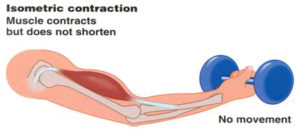 In contrast to isotonic contractions, isometric contractions generate force without changing the length of the muscle. This is typical of muscles found in the hands and forearm: the muscles do not change length, and joints are not moved, so force for grip is sufficient. An example is when the muscles of the hand and forearm grip an object; the joints of the hand do not move, but muscles generate sufficient force to prevent the object from being dropped.
For people with hypermobile joints, strength training can be a challenge. Tension stresses the connective tissues of the joint as force is transmitted through its range of motion. Isometric exercises can be ideal in these circumstances because there is minimal movement. This means that the joint is placed into vulnerable hyperextended positions under force.
In contrast to isotonic contractions, isometric contractions generate force without changing the length of the muscle. This is typical of muscles found in the hands and forearm: the muscles do not change length, and joints are not moved, so force for grip is sufficient. An example is when the muscles of the hand and forearm grip an object; the joints of the hand do not move, but muscles generate sufficient force to prevent the object from being dropped.
For people with hypermobile joints, strength training can be a challenge. Tension stresses the connective tissues of the joint as force is transmitted through its range of motion. Isometric exercises can be ideal in these circumstances because there is minimal movement. This means that the joint is placed into vulnerable hyperextended positions under force. You can develop amazing strength without free weights, machines, or resistance bands.
One of the original bodybuilder gurus from the 1920s, Charles Atlas, based his workouts primarily on isometric exercises, eventually even trademarking a term for his exercise method that he called "Dynamic Tension."
If you have hypermobile joints you can strength train safely at home with isometric exercises.
You can develop amazing strength without free weights, machines, or resistance bands.
One of the original bodybuilder gurus from the 1920s, Charles Atlas, based his workouts primarily on isometric exercises, eventually even trademarking a term for his exercise method that he called "Dynamic Tension."
If you have hypermobile joints you can strength train safely at home with isometric exercises.
